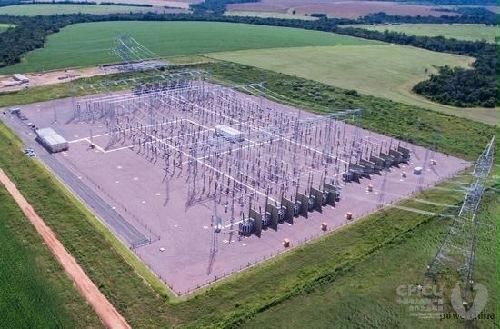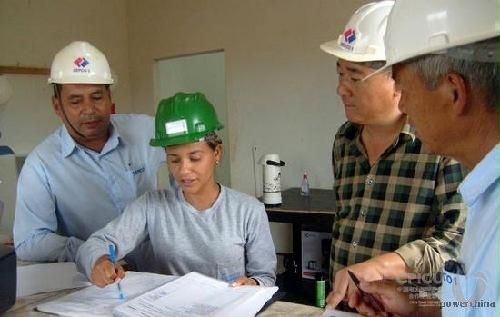On Aug 6 at 7:00am Beijing time, the 31st summer Olympic Games kicked off in Rio de Janeiro, southeast of Brazil. This is the first Olympic Games in history to be held in South America. The enthusiasm and free spirit of Latin American culture, crashing and blending with the “Faster - Higher - Stronger” spirit of Olympics, will definitely put Brazil and Rio under the global spotlight this summer.
As one of the world’s top 500 enterprises and a global leader in the power industry, POWERCHINA will most definitely be involved in the Rio Olympics. During the Games, the First Shandong Electric Power Construction Company (SEPCOI), an affiliated company of POWERCHINA which is undertaking the Brazil Mato Grosso 500kV Transmission Project, will proudly ensure power supply and contribute Chinese wisdom and strength to this Olympic Games.
Significance – break monopoly becoming the first, set an example for China-Brazil trade
Brazil Mato Grosso 500kV Transformer Engineering Project is a hydro-electric power transmission project in the Teles Pires River basin. The 500kV AC transmission line has the largest transmission capacity and longest transmission distance ever to be constructed in Brazil. With a total investment of 9,719 million yuan, the project is the first large-scale greenfield power transmission franchise project in which China has invested overseas, and is also the largest transmission project contracted and built overseas.
The project consists of two parts: the transformer substation and transmission lines. The substation consists of 3/2 wiring, two in and two out, and 21 sets of generating lines and line reactors. The station covers a total area of 8 hectares with buildings comprising an area of 370 square meters; transmission lines use same-pylon double-circuit overhead transmission lines and are supported by 651 pylons along a total distance of 356 km.
The project is jointly funded by the State Grid Corporation of China Brazil Holding Company and the Brazil Copel Power Company. The project owner is the Matt Lynn Rosa Power Transmission Company Limited, and the general contractor, SEPCOI. On Feb 5, 2013, the project obtained its construction permit from the SEMA Environment Protection Bureau of Mato Grosso State, construction commenced on March 21, 2013, and formally went into operation on Sept 28, 2015.
The Mato Grosso Project is not only currently one of the biggest projects between China and Brazil, but more importantly, the project signifies the breaking of the monopoly held by Spanish and Portuguese enterprises by Chinese grid enterprises, who have now successfully entered into a Brazilian power transmission and transformation project for the first time. It is also the first time that a Chinese power construction enterprise has disrupted the monopoly of Spanish and Japanese enterprises on the power transmission and transformation engineering construction market and the first time for such an enterprise has successfully entered the Brazilian market as a contractor of a power transmission and transformation construction project. It has huge pioneering significance and impact as a model project and is of immense practical significance for deepening Chinese and Brazilian economic ties as well as for the promotion of the expansion of the Brazilian electric power market.
Quality - you can trust Made In China
Quality determines trust. SEPCOI considers this project an important breakthrough in cracking open the Brazilian and South American power transmission market. From the very beginning of this project, the overall quality objectives set were "meet the contract requirements, create South America's best power transmission and transformation project and strive for the National Best Overseas Project award” and do our very best to create excellent quality engineering.
During the construction, SEPCOI always adhered to its guidelines of “plan-oriented, technological innovation, model guidance, attaining superior quality first time”, and compiled detailed engineering plans and detailed rules and regulations for application during project implementation in order to ensure outstanding quality. It developed secondary plans for key project segments and promoted standard technologies. It conducted comprehensive quality control over the whole process to turn the project into workmanship which is a joy to behold. The interior and exterior engineering foundations were well designed. Power distribution rooms were simply designed with a detailed focus on practical usage, the style and color of buildings and structures complement each other, and the arc of overhead wires, soft straps and equipment wire are consistent, smooth and beautiful, all of which amply demonstrate the excellent attention to quality in Chinese run power engineering projects. The project implemented 35 items on the “five-new list” of technologies, as well as one from State Key Energy-Efficient Technology Promotion Catalogues, six major and eleven minor technologies ranked as the construction industry’s top 10 new technologies.
The project utilizes materials and equipment produced in China with Chinese intellectual property rights, including substation protection and telecommunication equipment, insulators and fittings, as well as China-made construction machinery equipment, thereby boosting Chinese exports of power equipment and engineering machinery and significantly contributing to the promotion of trade between China and Brazil.
The project has passed the Acceptance and Operation Examination, Power Engineering Application of New Technology Model Project acceptance test, Power Engineering Green Construction Model Project acceptance test with a 100 percent pass rate. It was incident-free in safety and quality, and was evaluated as an excellent project of high quality following inspections. The project has been awarded a third prize by the National Excellent Construction Quality Management Group, won 12 provincial and ministerial QC achievement awards, four provincial and ministerial Science & Technology Progress awards, theee provincial and ministerial Construction Method awards, 15 patents, and the 2016 China Electric Power Quality Project Award. Since its completion and commencement of operation, the project has demonstrated safe and reliable performance, accumulating 310 days of safe operation and sent a steady flow of clean water and electricity to Southeast Brazil, creating huge economic benefits.
The project has become a local “star project”, the owners and the local Chinese Embassy have paid close attention to and have highly praised the project. The International channel of Xinhua.net produced a special report on the engineering progress of this project, provoking strong overseas interest.
Now the project is applying for a gold medal of national best overseas project award and is striving for the highest honor in the overseas field.
Responsibility - green construction, good for locals and sustainable development
POWERCHINA is a synonym for responsibility everywhere. The Mato Grosso project is no exception.
The project uses same-pylon double-circuit transmission lines, effectively saving 1,993.6-hectares of line corridors. It uses full digital aviation photography and remote sensing technology for route optimization, using tall pylons in forested areas and towers with legs of differing heights in mountainous areas, significantly protecting vegetation and the existing topography. The project extensively utilized large spiral posts in 53 percent of instances in the transmission line foundations for the first time, reducing excavation volume by 58,875m³, substantially reducing earthwork excavation induced soil erosion and vegetation damage. The trusses of whole transformer substation use angle-steel structure, 68 percent of transmission towers use a “Y”-shape guyed tower, saving steel 2,940 tons of steel. The transmission lines use new damping spacer lines with an average span of 131 meters, reducing the amount of spacers to 8,641 sets. The guyed tower bases extensively utilize prefabricated foundations with industrial distribution, significantly reducing on-site construction damage to the environment. The transform substations use 96 deep piles and 851 helical piles in substation bases, which not only meet the bearing capacity of soft soil foundations but also substantially reduces excavation and production workloads of the foundation. The transmission lines going in and out as well as the generating reactor utilize a 3+1 configuration, boosting load efficiency of the substation power output, achieving the users’ requirements as well as reducing environmental impact and provided uninterrupted power supply.
The Mato Grosso Project’s operation displays wide-range long-distance green energy transmission and plays an important role in advancing the economic development of north Brazil whilst alleviating power shortages in the main economic regions in the southeast, and will play a huge part in the Olympics Games. The project demonstrates significant benefits to reducing energy wastage as well as environment protection. Compared to a coal-power project in southeast Brazil, the project can save 2.89 million tons of coal per year, eliminating 8.75 million tons of carbon dioxide emissions, 1,800 tons of sulfur dioxide emissions, 3,500 tons of nitrogen oxides emissions and 700 tons of dust emissions.
In addition, the project also offers jobs for at least 200 Chinese and 5,000 Brazil employees, effectively stimulating local employment and improving the income and well-being of local residents.

The Brazil Mato Grosso 500kV power transmission lines panorama.

The Brazil Mato Grosso 500kV transmission project substation

Chinese and Brazilian technical staff carry out research.

